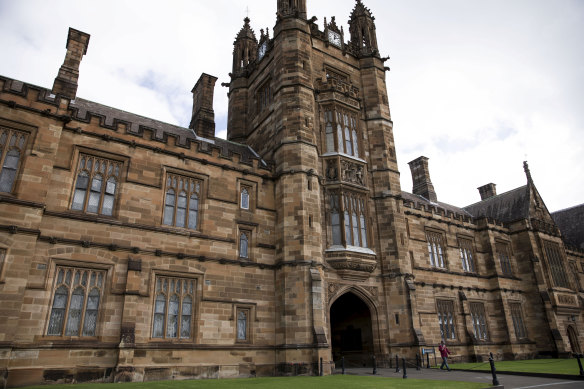By Lucy Carroll and Adam Carey
Three Sydney universities have climbed the ladder in the latest world rankings, while seven Australian institutions cracked the top 100, up from six last year.
The University of Sydney, University of Technology Sydney and Macquarie University lifted their positions in the latest Times Higher Education world university rankings for 2023, while the University of NSW slid by one place.

The University of Sydney lifted its position from 58th to 54th in the Times Higher Education rankings.Credit: Dominic Lorimer
Melbourne is home to two of the world’s 50 top-ranked universities for the first time, with Monash surging into second place in Australia, behind the University of Melbourne which held its spot as Australia’s highest-ranked university but slid from 33rd to 34th overall.
The two Victorian institutions are the only Australian universities to finish in the top 50, among 10 that finished in the top 200 this year, down from 12 last year.
The University of Sydney lifted its position from 58th to 54th, while UTS continued to rise by 10 places to 133rd and Macquarie University improved its standing by 17 places to 175th. UNSW moved down one place to 70th.
Times Higher Education said Australia had held a strong overall position in the global rankings, driven by high levels of research funding, strong research productivity and international collaboration, as well as a healthy overseas student market.
Phil Baty, the chief knowledge officer at Times Higher Education, said the bigger picture remained remarkably healthy for Australia, though the rankings data did not yet reflect much of the fallout from the pandemic, such as the financial consequences of border closures.
“There can be no room for complacency,” Baty said. “The COVID response hit Australia harder than many of its key competitor nations, in terms of border controls, and the rankings are increasingly competitive, with more universities from more countries taking part than ever before.”
“At the top of the table, Melbourne will have bragging rights: it now boasts Australia’s number one and number two universities,” he said.
Monash was among the biggest improvers nationally, jumping from 57th to 44th place, overtaking the University of Queensland, the University of Sydney and the Australian National University compared with last year’s rankings.
The rankings are important for universities in their quest to attract international students, a $37 billion industry for Australia before the pandemic hit, and an essential source of revenue for tertiary institutions.
But the rankings are also controversial, with some experts arguing they overemphasise universities’ research output, at the expense of teaching.
Sixty per cent of the ranking points universities accrue are based on research and citations, compared with 30 per cent for teaching.
This month, the Productivity Commission warned that rankings detract from universities’ incentive to invest in quality teaching.
“International rankings, which are heavily weighted towards research outputs, play an important role in attracting students, particularly international students. This means that universities’ incentives are poorly aligned with delivering quality teaching,” the commission said in its interim report on Australia’s education system.
For the seventh straight year, Oxford University has landed top position, followed by Harvard Cambridge, Stanford and Massachusetts Institute of Technology.
Higher education expert Professor Andrew Norton, from ANU’s Centre for Social Research and Methods, said a big shift in a university’s ranking could have financial repercussions because international students do follow them, particularly in China.
But he said they had negligible influence in the domestic market, where the ATAR (Australian Tertiary Admission Ranking) drives student choice.
“The trouble with this ranking is it has a large number of elements to it, and it includes things that are subjective, like a reputation survey,” Norton said.
Our Breaking News Alert will notify you of significant breaking news when it happens. Get it here.